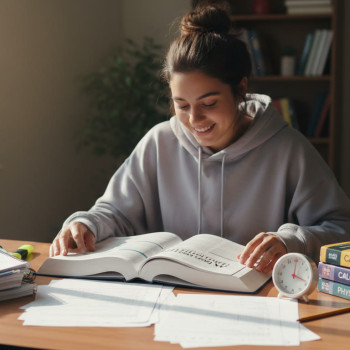Cross-Math: When to Use Algebraic vs Graphical Reasoning
There’s a quiet moment in an exam when a problem sits on the page like a fork in the road: do you reach for algebraic manipulation, or do you sketch a graph and trust your visual intuition? That split-second decision can change not only how quickly you solve a question but whether you get it right at all. In this guide we’ll make that moment less scary — practical, tactical, and human. Think of this as the pocket guide you wish you’d had during every practice test.

Why the choice matters
Algebraic and graphical reasoning are two languages for the same mathematical ideas. Algebra gives you exactness, symbolic power, and logical chains. Graphical reasoning offers intuition, pattern recognition, and quick estimation. On an AP exam — whether it’s Calculus AB/BC, Statistics, or AP Physics with heavy math — using the right language for the right problem saves time and reduces errors.
Here are three practical consequences of choosing well:
- Speed: Graphical insight can be faster for visual problems; algebra is typically faster when you need a precise numeric answer.
- Accuracy: Algebraic methods reduce ambiguity when the question asks for exact values; graphical approaches can mislead if you depend on rough sketches.
- Strategy: Smart problem solvers mix both—start graphically to form a hypothesis, then prove algebraically (or the other way around).
Quick checklist: Which approach to try first?
Before diving into solution steps, run this mental checklist. If several items apply, prefer the corresponding approach.
- Try graphical first when: the problem asks for behavior (increasing/decreasing), approximate roots, intersections, maxima/minima locations, or visual comparisons between functions.
- Try algebraic first when: you’re asked for an exact value, you have constraints that simplify algebra (factorization, substitution), or the question is clearly symbolic (prove, simplify, derive).
- Combine both when: you need a sanity check, when an algebraic solution is messy but a graph can validate a numeric answer, or when you want an approximate answer quickly before refining it.
A quick decision flow
If you like mental flowcharts, here’s a short one to run in your head:
- Does the question ask for an exact symbolic answer? → Algebra.
- Is the question asking about relative position, intersection, or trend without exactness? → Graph.
- Does the algebra look messy? → Sketch a graph to check or estimate before committing.
Architecture of a good solution: blend, don’t battle
The students who look effortless in exams don’t always choose one method and stick with it — they switch intelligently. Here’s a reliable three-step architecture you can use:
- Preview visually. Spend 10–30 seconds sketching or imagining the graphs and key features: intercepts, asymptotes, and behavior at extremes.
- Hypothesize. Make a short prediction: “I think there’s one root near x=1 and a maximum near x=3.” This frames your algebraic work and reduces aimless manipulation.
- Confirm algebraically. Use algebra to compute, simplify, or solve exactly. Use your graphical prediction to pick the sensible root if the algebra produces multiple possibilities.
Worked examples: see the tradeoffs in action
Below are classic problem types you’ll meet on AP exams. For each we show a short graphical approach and an algebraic alternative, then explain which is preferable and why.
Example 1 — Finding intersections
Problem: Find the x-values where f(x) = x^2 – 2x and g(x) = 2x – 3 intersect.
Graphical approach: Sketch both curves — the parabola with vertex at x=1 and the line with slope 2. Visually you can estimate intersection points near x = -1 and x = 3.
Algebraic approach: Solve x^2 – 2x = 2x – 3 → x^2 – 4x + 3 = 0 → (x-1)(x-3) = 0 → x = 1, 3.
Decision note: The graph gave useful intuition and a quick guess, but algebra yields the exact roots. If the exam asks for exact values, algebra is necessary. If it asks for how many intersections or a rough sketch, the graph is faster.
Example 2 — Approximating complicated roots
Problem: Estimate a root of h(x) = e^x – 3x on the interval [0,2].
Graphical approach: Plot or imagine e^x (growing exponential) and 3x (line). You can see they cross once somewhere between x=0 and x=1. A quick sketch suggests around x≈0.6–0.7.
Algebraic approach: There’s no closed-form algebraic solution. Use Newton’s method or a calculator. Start with x0 = 0.7 and iterate.
Decision note: Use a graph to find a good initial guess, then apply algebraic/numeric methods to refine. This hybrid approach saves time and improves convergence — a tactic that’s golden for AP problems that require approximate numeric answers.
Example 3 — Optimization
Problem: Maximize A(x) = 2x(10 – x) on the domain x in [0,10].
Graphical approach: Recognize A(x) as a downward-opening parabola with zeros at x=0 and x=10 — the maximum is at the vertex, visually at x=5.
Algebraic approach: Compute derivative A'(x) = 20 – 4x. Set to zero: 20 – 4x = 0 → x = 5. Evaluate A(5) = 50.
Decision note: A quick sketch gives the answer almost immediately. Algebra confirms it and gives the exact maximum. For optimization problems, graphs tell you where to look and algebra gives precision; they work hand-in-hand.
Table: Side-by-side tradeoffs
| Problem Type | When Graphical Wins | When Algebraic Wins |
|---|---|---|
| Find number of intersections | Quick visual count, approximate locations | Exact intersection points; required if exact values asked |
| Root estimation | Good initial guesses, detect multiplicity | Numeric methods (Newton, bisection) or analytic if solvable |
| Optimization | Spot maxima/minima location by shape | Derivative tests give precise values and confirm concavity |
| Behavior at infinity or asymptotes | Visual understanding of end behavior | Limits provide formal justification and exact behavior |
| Piecewise definitions | Sketch to see continuity and transition points | Algebra to compute exact boundaries and evaluate pieces |
Practical tips to make both methods work for you
These are the habits you can build now that pay off on test day.
- Always do a quick sketch. Even a rough drawing (not to scale) reveals behavior and saves careless mistakes.
- Annotate your graph. Mark intercepts, asymptotes, and turning points — they’re your anchors for algebraic reasoning.
- Use algebra to prune possibilities. If algebra produces several candidate solutions, use the graph to reject extraneous roots or to choose the realistic one for the context.
- Don’t overtrust your eyes. Small differences on a tiny sketch can lead to wrong conclusions. Use algebra when exactness matters.
- Know your calculator tools. On many AP exams you may use graphing calculators — know how to trace intersections, numerically solve, and find local extrema. But remember: calculators are tools, not crutches.
Common pitfalls and how to avoid them
Students often make the same mistakes when switching between methods. Here are the traps and the simple ways out.
- Pitfall: Sketch is too rough to be useful. Fix: Label axes and important features; even crude coordinates help.
- Pitfall: Algebra yields extraneous solutions from squaring or domain errors. Fix: Check solutions against the original equation and the graph’s domain visually.
- Pitfall: Relying solely on calculator graphs without understanding. Fix: Use the graph to guide, then do a hand calculation or a short algebraic check to justify the result.
- Pitfall: Time sink — spending too long perfecting a sketch. Fix: Limit sketches to 20–30 seconds unless the problem explicitly calls for a detailed graph.
How to practice this skill effectively
Skills are habits formed by practice. Try the following practice plan over a two-week cycle and you’ll notice measurable improvement.
- Day 1–3: Pick 10 problems each day that are typical of AP exams. For each problem, force yourself to spend up to 30 seconds sketching before solving.
- Day 4–6: Choose problems where algebra is messy. Use graphs to generate hypotheses, then apply algebraic techniques to confirm.
- Day 7: Take a timed mini-quiz mixing both styles. Afterward, review every problem and annotate whether your initial method choice was optimal.
- Week 2: Repeat with harder questions and reduce sketch time to 10–15 seconds to build quick visual intuition.
Example practice set (with suggested approach)
- Intersection of a line and quadratic — Start graphically, finish algebraically.
- Maximizing area under a curve with constraints — Sketch first, use derivatives algebraically.
- Solving a transcendental equation (e^x = ax + b) — Graph for initial guess, then Newton/bisection.
- Piecewise function continuity at a boundary — Draw, annotate, solve algebraically for parameters.
When exam pressure pushes you — a quick decision triage
During a timed section, you don’t have the luxury for long deliberation. Use this micro-triage:
- If it’s multiple choice: Graph quickly — a visual estimate can eliminate wrong choices fast. If two choices look similar, then run a short algebraic check for the deciding criteria.
- If it’s free-response and asks for justification: Use both. A quick graph for intuition and algebraic steps for the formal answer work best.
- If you’re stalled: Sketch. Graphs break mental logjams by giving you a new perspective immediately.

How tutoring can accelerate this intuition
One-on-one tutoring shifts practice from shotgun to sniper. A skilled tutor spotlights when a graphical idea will likely work and when algebraic rigor is indispensable. Personalized tutoring — for example, Sparkl’s 1-on-1 guidance — can craft tailored study plans that emphasize your weaknesses: if you hesitate to sketch under pressure, your tutor can design rapid-sketch drills; if you over-rely on algebra, they can show visual shortcuts and sanity checks.
Some concrete benefits of personalized tutoring for this cross-method skill:
- Targeted drills that simulate exam timing and build quick sketch fluency.
- Customized problem sets that alternate between algebra-first and graph-first approaches so you learn to switch effortlessly.
- Expert feedback that identifies recurring decision errors and corrects them with clear, repeatable rules.
- AI-driven insights (when available) that track your method choices and suggest when you should practice graphs versus algebra based on performance trends.
Real-world context: why both ways matter beyond the exam
In science, engineering, and data work, the skill of switching between algebraic exactness and graphical intuition is fundamental. Engineers sketch load diagrams before they run exact calculations. Data scientists visualize distributions before computing precise metrics. Learning to navigate both strengthens your mathematical thinking and prepares you for real tasks where both speed and correctness matter.
Sample mixed-problem: full solution walkthrough
Problem: Let f(x) = (x^3 – 3x)/2 and g(x) = sin(x). On the interval [-3,3], estimate how many times the graphs intersect and find approximate solutions.
Step 1 — Graphical preview: Sketch both. f(x) is an odd cubic scaled by 1/2 with roots at x = -√3, 0, √3 and inflection at the origin. sin(x) is bounded between -1 and 1 and oscillates. Visually, we expect intersections near the roots and perhaps additional ones where the cubic crosses the sine curve within the box y ∈ [-1,1].
Step 2 — Hypothesis: Likely three intersections: near -1.7, 0, and 1.7 (the cubic’s real roots are approximately ±1.732 and 0). But because sin(x) ≈ x around 0, 0 is definitely an intersection.
Step 3 — Algebraic check: Solve (x^3 – 3x)/2 = sin(x). There’s no closed-form solution; use numeric methods. Use the graph to pick initial guesses: x0 = -1.7, x1 = 0, x2 = 1.7. Run Newton or use a calculator solver to refine to x ≈ -1.732, 0, 1.732. Check consistency: sin(±1.732) is about sin(1.732) ≈ 0.989 and (1.732^3 – 3*1.732)/2 ≈ 0.989 — they match to three decimals.
Conclusion: The graph helped you spot all reasonable initial guesses and the algebraic/numeric method produced accurate approximations. This is a textbook hybrid solution: visual intuition + numerical algebraic confirmation.
Checklist for test day
- Bring a clean strategy: sketch first for unfamiliar problems, algebra first when exactness is required.
- Limit sketch time: 10–30 seconds. Use it to formulate hypotheses, not to produce a perfect graph.
- Use your graphing calculator wisely: trace intersections and verify extrema, but always annotate and cross-check by hand.
- When in doubt, mix: a graph to guide; algebra to prove.
Parting thoughts: math is conversation, not combat
Treat algebra and graphs like two friends with complementary skills. Graphs are the storyteller — they give shape, context, and a quick narrative. Algebra is the fact-checker — exact, sometimes unforgiving, and necessary. Learning to listen to both will not only raise your AP scores but reshape how you think about problems: less panic, more pattern recognition, and a steady rhythm of predict, test, and confirm.
If you want to accelerate that rhythm, targeted help can make all the difference. Personalized tutoring — for instance, Sparkl’s tailored study plans, expert tutors, and AI-driven insights — can focus your practice on the exact decision points where you hesitate. With the right practice, the fork-in-the-road becomes a confident step forward.
Want to try it now?
Next time you practice, pick five problems and force yourself to alternate approach order: two you solve graph-first, two algebra-first, and one you must solve by switching. Time yourself. Review decisions. The small habit of deliberate alternation trains your brain to recognize the right language for the right problem. Over weeks, that tiny change yields big gains.
Final encouragement
Mastery doesn’t mean you always pick the best method immediately — it means you know how to recover fast and verify confidently. Make graphs your quick scouts and algebra your final jury. Practice switching between them, and test day won’t feel like a fork in the road — it will feel like a familiar route you know how to navigate.



















No Comments
Leave a comment Cancel